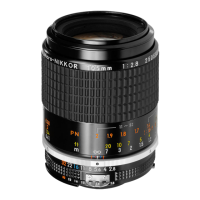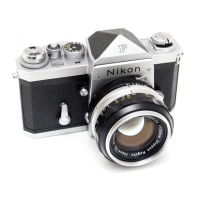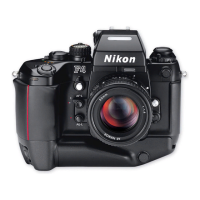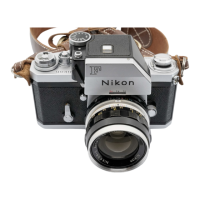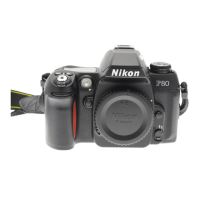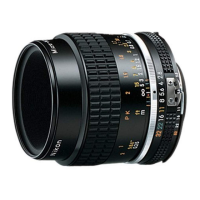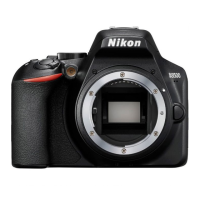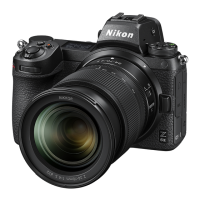What to do if film is not correctly advanced in Nikon Digital Camera?
- PpweaverSep 10, 2025
If the film is not correctly advanced in your Nikon Digital Camera, reload the film.
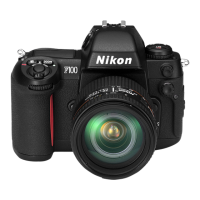
What to do if film is not correctly advanced in Nikon Digital Camera?
If the film is not correctly advanced in your Nikon Digital Camera, reload the film.
What to do if Nikon Digital Camera batteries are just about exhausted?
If your Nikon Digital Camera batteries are just about exhausted, turn the power off and replace the batteries with new ones.
What to do if non-CPU lens is attached to Nikon F 100?
If your Nikon Digital Camera has a non-CPU lens attached or no lens attached, attach a CPU lens (except IX-Nikkor). With a non-CPU lens, set the exposure mode to A or M and set the aperture with the lens’ aperture ring.
What to do if my Nikon F 100 Digital Camera detects a malfunction?
If your Nikon Digital Camera indicates a malfunction, try releasing the shutter again. If the warning persists or appears frequently, it is recommended to contact an authorized Nikon dealer or service center.
What to do if Nikon F 100 Digital Camera batteries are exhausted during film rewind?
If your Nikon Digital Camera batteries are exhausted during film rewind, turn the power off, replace them with new ones or recharge them, and turn the power on again to rewind the film. If this warning appears frequently, contact an authorized Nikon dealer or service center.
How to fix overexposure on Nikon F 100?
If overexposure may have occurred with your Nikon Digital Camera, use an ND filter in P mode. In S mode, select a faster shutter speed. In A mode, select a smaller aperture (larger f-number). If the warning indication remains after performing the above remedies in S or A mode, use an ND filter as well.
Why does Nikon F 100 battery drain fast in cold weather?
At extremely low temperatures, your Nikon Digital Camera may not function properly with old batteries. Use a fresh set of batteries, keep spare batteries warm, and use them alternately.
What to do if film remains in Nikon Digital Camera after rewind?
If the film remains in the camera after film rewind is complete in your Nikon Digital Camera, remove the film cartridge.
How to fix autofocus on Nikon Digital Camera?
If autofocus is not possible with your Nikon Digital Camera, focus manually.
What to do if shooting data is full in Nikon F 100 Digital Camera?
If your Nikon Digital Camera indicates that shooting data is full in F100’s memory, turn the power switch off once and on again. The warning indication will disappear, and additional data will not be recorded until the data in the memory is erased.
| Brand | Nikon |
|---|---|
| Model | F 100 |
| Category | Digital Camera |
| Language | English |
Identifies the camera's focus mode selector dial and its function.
Details the location and purpose of the Main and Sub-Command Dials.
Indicates the location of the camera's LCD panel for displaying settings.
Shows the selector for choosing autofocus area modes.
Explains the various indicators and information shown on the LCD panel.
Details the information displayed within the camera's viewfinder.
Describes how exposure compensation is indicated on the LCD and viewfinder.
Explains how to set the film speed using the command dials.
Guides on selecting different exposure modes using command dials.
Details how to access and navigate the Custom Setting menu.
Highlights the key features and technologies of the Nikon F100 camera.
Provides advice on maintaining and servicing the camera.
Introduces the steps for basic camera operation.
Explains each camera function in detail.
Step-by-step guide to inserting batteries and checking power levels.
Instructions for attaching and detaching lenses to the camera body.
Procedures for loading film into the camera and advancing to the first frame.
Guides on selecting focus mode, focus area, and AF area mode.
How to select metering system and exposure modes.
Techniques for holding the camera and achieving focus.
Steps to confirm viewfinder information and take a picture.
Explains the different metering systems available on the camera.
Describes how shutter speed and aperture control exposure.
Details compatibility for G-type and other CPU Nikkor lenses.
Explains how to use non-CPU lenses and their limitations.
Lists Nikkor lenses and accessories that cannot be attached.
How to set and check the film speed.
Explains the different film advance modes (Single, Continuous).
Instructions for rewinding film before the roll is finished.
Explains Single Servo AF and Continuous Servo AF modes.
How to choose the focus area for precise focusing.
Describes the function of the AF start button.
Focuses on using a single selected focus area for sharp focus.
Explains how Dynamic AF tracks moving subjects across multiple areas.
Details AF mode prioritizing the closest subject.
How to position the focus area and lightly press the shutter.
Steps to confirm focus and lock it for recomposing.
Lists conditions where autofocus may not work as expected.
Guidance on using manual focus when autofocus fails.
How to choose between Matrix, Center-Weighted, and Spot metering.
Explains the characteristics of Center-Weighted Metering.
Details the Matrix and 3D Matrix Metering capabilities.
Describes the Spot Metering system for precise exposure.
Guide to using the Programmed Auto exposure mode.
General steps for composing and taking a picture.
How to set shutter speed for correct exposure.
Method to lock the selected shutter speed.
How to set aperture for depth of field control.
Method to lock the selected aperture.
How to manually set shutter speed and aperture.
Understanding the analog exposure display in the viewfinder.
Steps to measure exposure and lock it.
How to recompose the shot while maintaining locked exposure.
How to adjust exposure compensation using the command dial.
How to initiate Auto Exposure/Flash Exposure Bracketing.
Selecting the number of shots and EV compensation.
Explains bracketing options using 1/3 EV steps.
Explains bracketing options using 1/2 EV steps.
Explains bracketing options using 1 EV steps.
How to set the film advance mode for multiple exposures.
Adjusting exposure compensation for multiple shots.
Setting Manual mode for exposures over 30 seconds.
How to use Bulb mode and set the aperture.
How to adjust the diopter for clear viewfinder vision.
How to use the LCD illuminator for dark conditions.
How to preview the depth of field.
Understanding the film plane indicator on the camera.
Step-by-step guide to remove the existing focusing screen.
How to install a new focusing screen.
Instructions for attaching the optional Data Back MF-29.
How to use the self-timer for group shots.
Setting the film advance mode for self-timer use.
Final steps to compose, focus, and activate the self-timer.
Explains how aperture, distance, and focal length affect depth of field.
Details how the camera tracks moving subjects for focus.
How to create personalized camera settings.
Steps to select and customize menu settings.
Setting automatic film rewind at the end of the roll.
Changing the increment steps for exposure values.
Customizing the order of bracketing exposures.
Continuous focus area selection options.
Enabling AE Lock by lightly pressing the shutter.
Options for Dynamic AF mode with closest subject priority.
Customizing bracketing to include Auto or Flash only.
Simplifying exposure compensation adjustments.
Adjusting the delay time for auto meter switch-off.
Setting the delay time for the self-timer.
Customizing AE-L/AF-L button functions.
How to reset camera settings to factory defaults.
Lists settings affected by the two-button reset.
Explains the multi-sensor fill-flash modes.
Details the Center-Weighted Fill-Flash mode.
Describes the Standard TTL Flash mode.
Explains the accessory shoe for mounting speedlights.
Details the sync terminal for external flash cords.
Explains the ready-light for flash charge status.
How to select flash sync modes using the command dial.
Explains Rear-Curtain Sync for motion blur effects.
Describes the Red-Eye Reduction feature.
Details the standard Front-Curtain Sync mode.
Explains Slow Sync for background illumination.
Lists compatible Nikon Speedlights and their features.
Important considerations when using optional speedlights.
Steps for attaching a speedlight and setting the metering system.
How to set the exposure mode and check shutter/aperture.
Selecting the appropriate flash sync mode.
Powering on the speedlight and selecting TTL auto flash mode.
Shows how focus mode and AF Area mode work together.
General description of the F100 as a high-performance camera.
Details battery holders and high-speed battery packs.
Lists chargers, eyepieces, and correction lenses.
Information on right-angle viewers and focusing screens.
Explanation of different types of Nikon filters.
Overview of available Nikon lenses for the F100.
Details on the optional Data Back MF-29 for imprinting data.
Information on specific Nikon speedlight models.
Details on the SU-4 controller for wireless flash.
Accessories that connect to the 10-pin remote terminal.
Information on camera soft cases and carrying straps.
Instructions for cleaning the camera body, mirror, and lens.
Warnings regarding vibration, shock, electric fields, and shutter curtains.
Guidelines for storing the camera in cool, dry conditions.
Advice on avoiding condensation due to temperature changes.
Safety warnings and tips for battery usage and replacement.
Common problems and their solutions for the LCD panel and viewfinder.
Solutions for over/underexposure and exposure range errors.
Troubleshooting autofocus failures and film rewind issues.
Technical details on camera type and supported exposure modes.
Specifications for autofocus module and lens mount compatibility.
Details on metering systems, exposure compensation, and AE Lock.
Technical specifications for shutter speeds and sync contacts.
Details on flash control and available sync modes.
Specifications for film advance speed and rewind functions.
Information on power sources and terminal connections.
Data on exposure meter operation and battery life.
Overview of custom settings and the two-button reset feature.
Physical specifications and optional accessories.
Custom settings for film rewind and exposure value increments.
Settings related to autofocus activation and non-DX film warnings.
Customizing AE Lock and bracketing behavior.
Settings for switching command dial operations and easy exposure compensation.
